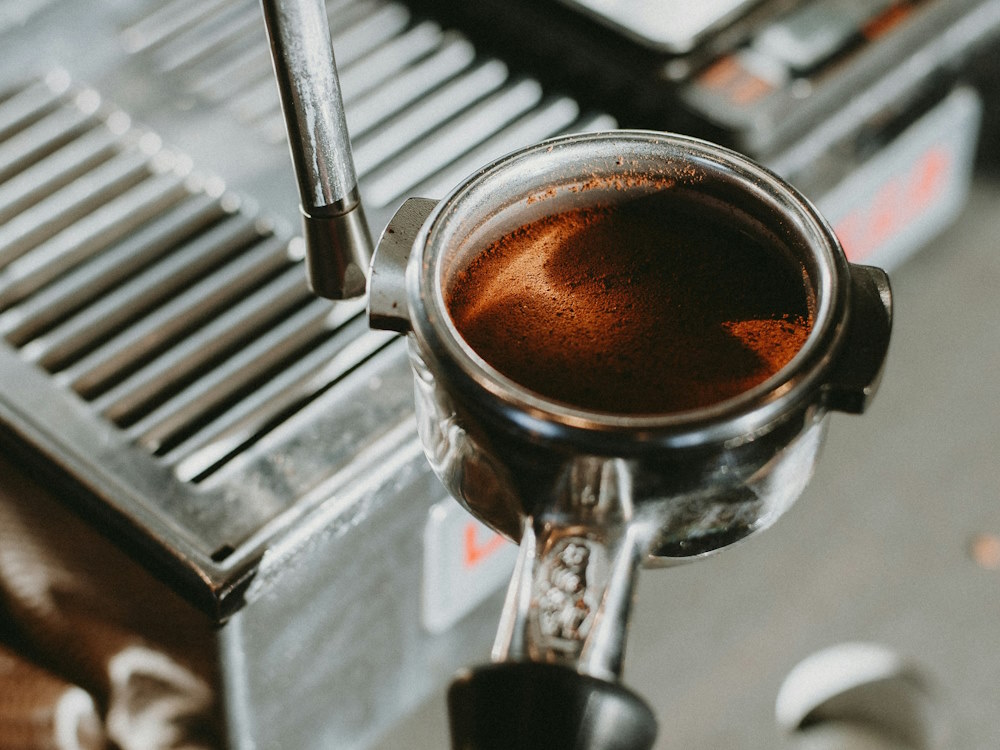There are a certain number of variables you need to tweak and control if you want to extract great espresso – think dose, grind size, brew temperature, and yield, to name a few.
Although these factors all play a key role in pulling an excellent shot, there is one vital aspect that is often overlooked: how clean your espresso machine and grinder are. Without using well maintained and clean equipment, it’s near to impossible to prepare delicious espresso with delicate and complex flavour profiles.
For coffee shops, this means developing rigorous daily and weekly cleaning schedules, as well using high-quality cleaning equipment, to get the best results.
To learn more, I spoke to Jason Bond, International Business Manager at Cafetto, and Christopher Short, Director at Cafetto. Read on for their insight on how to properly maintain your espresso machine and grinder.
You may also like our article on why the push for perfect espresso will never stop.

How to prepare great espresso
Pulling the perfect shot is somewhere between a fine art and an exact science. Baristas need to control and fine tune a broad range of different variables, while still flexing their creative skills and well-developed palates.
In an ever-evolving specialty coffee industry, there is a seemingly endless list of extraction variables that baristas have to monitor and analyse if they want to get the best results. In addition to changing grind size, dose, yield, and brew time, baristas have also started to focus on more intricate factors like flow rate, pressure profiling, and pre-infusion. Essentially, experimenting with these variables means you can control how much water passes through the puck at any given time – and thereby the flavours and aromas that you extract.
Additionally, puck preparation is another key step. Using the right tamping and distribution techniques means baristas can evenly disperse ground coffee throughout the portafilter, which increases the chances of a more uniform extraction.
So to carry out all these steps, baristas need effective and thorough training. Learning these skills takes time and patience, and just one simple mistake or misstep can lead to a significant drop in coffee quality.
Preparing great espresso, however, requires more than acquiring a solid set of skills. If coffee shops want to consistently serve excellent drinks to their customers, investing in high-quality equipment, like espresso machines and grinders, is an absolute must.
In line with this, baristas and business operators need to know how to take care of and properly clean their equipment.

Why is it so important to clean espresso machines and grinders?
With all the attention to detail that goes into preparing espresso, using poorly maintained and inadequately cleaned equipment can quickly undo all the effort.
Jason Bond is the International Business Manager at Cafetto – a specialist manufacturer of cleaning and sanitation products for espresso machines, grinders, and other coffee brewing and dispensing equipment.
“You know that underwhelming, watery-tasting coffee? Or better yet, that overly bitter-tasting espresso? Chances are that oil and residue build-up are compromising the flavour of the coffee,” he explains. “The harsh reality is you can always taste when a machine isn’t clean – and your customers will notice straight away.”
Coffee contains natural oils, and some will inevitably remain on group head screens, espresso machine pipes, or grinder burrs – as well as in other brewing equipment. Over time, these oils can build up, and if not removed, will impart stale and off flavours in espresso and filter coffee.
The same goes for old coffee grounds, which can quickly accumulate in grinders if not cleaned regularly and adequately. Moreover, the much finer grind size we use for espresso means grinders can easily clog if old grounds aren’t removed – which can potentially damage your equipment.
Taking care of your equipment
Christopher Short is the Director of Cafetto – which will exhibit at booth F313 at World of Coffee Busan from 1 to 4 May 2024.
He explains how cleaning espresso machines and grinders regularly is imperative to keeping them in good working condition.
“Studies show that grind speed and burr temperature remain consistent for longer when you regularly clean your grinder – which prolongs burr lifespan and means you don’t need to replace parts so often, which can be costly,” he says. “Similarly, espresso machine cleaners remove oil and residue build-up, which can cause your espresso to taste bitter, or your machine can even break down over time.”
He adds that Cafetto manufactures and sells around 80 different cleaning products for espresso machines, grinders, and milk jugs, including descalers and sanitisers – and explains how some of them work.
“The EVO espresso machine cleaner and grinder cleaner’s rapidly soluble and phosphate-free formulation helps remove old grounds, oils, and stains,” Christopher says. “It’s also non-corrosive and doesn’t damage your machine.
“Our grinder cleaner, meanwhile, reduces blockages between burrs and in the internal chambers, while also cleaning casings to help extend the lifespan of the equipment,” he adds. “You also don’t need to disassemble the grinder to clean it.”

Using high-quality cleaning products is essential
In an increasingly competitive market, it’s more important than ever for coffee shops to invest in premium commercial equipment to make sure they serve excellent espresso and filter coffee.
Similarly, they also need to use high-quality cleaning products and tools to get the best results from their espresso machines and grinders.
“As machines become more advanced, their performance is only reinforced by the cleaning products we use to help them reach their full potential,” Jason explains. “Your cleaning schedule and practices need to be backed up by high-quality products to ensure everything is hygienic, from machine to cup.
“Cafetto has always prided itself on our internal capabilities and quality control,” he adds. “We handle all the manufacturing, formulation testing, and regulatory and compliance control in-house, which means we can uphold our commitment to our customers to deliver high-quality, high-performing products.”
Like with any cleaning product, espresso machine and grinder cleaners must be food safe, and safe for staff to handle while wearing any personal protective equipment.
In line with this, Christopher explains that Cafetto products are tested and manufactured in strict compliance with numerous certification standards, including Australian Certified Organic. The company also holds a range of environmental and quality certifications, such as ISO 14001 Environmental Management and HACCP Food Safety.
Moreover, he adds that the brand’s standards have helped to establish sponsorships and partnerships with some of the leading events and competitions in specialty coffee.
“Cafetto’s involvement in coffee events is about celebrating everyone involved,” Christopher tells me. “From the competitors’ unique talent to the judges to the event organisers, we have sponsored competitions like the World Barista Championship for over 21 years.
“It’s our way of supporting the next generation of world champions and putting them in the spotlight,” he adds.

Creating a schedule
For coffee shops to operate effectively, baristas need to develop a solid workflow. To do this, staff should be organised and attentive – and this extends to cleaning equipment and machinery.
On top of investing in high-quality cleaning products, implementing proper daily and weekly cleaning schedules for espresso machines and grinders is of the utmost importance. Essentially, this also means that baristas need to receive the right level of training.
“We recommend thoroughly cleaning your espresso machine and grinder at the end of every day during close down to maximise performance and lifespan,” Christopher says. In a café setting, espresso machines and grinders are in constant use, so cleaning them at least once per day ensures old coffee grounds and oils are removed.
Organising your cleaning process
In a busy coffee shop, baristas may feel like they don’t have enough time to serve drinks, engage with customers, and keep on top of cleaning jobs all at once. What’s more, during busy rushes, spending time cleaning espresso machines or grinders can seriously impede workflow and disrupt service.
If equipment isn’t constantly cleaned and maintained, however, beverage quality can easily slip.
“Our goal is to eliminate the stigma that cleaning your machine is ‘difficult’ or ‘time-consuming’,” Jason explains. “We provide easy-to-follow directions for baristas of all experience levels.”
He adds that Cafetto’s pre-portioned sachets and pre-dosed tablets can help optimise the cleaning process – and ensure baristas stay on top of cleaning duties while still focusing on other tasks.

Controlling and experimenting with different extraction variables is essential to produce excellent espresso – but properly cleaning your equipment is just as important.
Investing in quality cleaning products is the first step, but baristas also need to know how to use them. By training staff properly and creating rigorous cleaning schedules, coffee shops will get the best out of their espresso machines and grinders.
Enjoyed this? Then read our article on whether natural processed coffees are the best choice for espresso.
Photo credits: Cafetto, Specialty Coffee Association
Perfect Daily Grind
Please note: Cafetto is a sponsor of Perfect Daily Grind.
Want to read more articles like this? Sign up for our newsletter!
The post Serving excellent espresso means using clean equipment appeared first on Perfect Daily Grind.
By: Bhavi PatelTitle: Serving excellent espresso means using clean equipment
Sourced From: perfectdailygrind.com/2024/04/how-to-clean-espresso-machine-grinder/
Published Date: Mon, 29 Apr 2024 05:27:00 +0000
Did you miss our previous article...
https://coffeecutie.com/espresso-brewing/rocket-appartamento-tca-home-barista-espresso-machine-for-50-per-month






